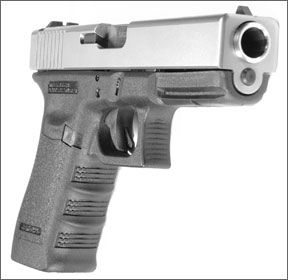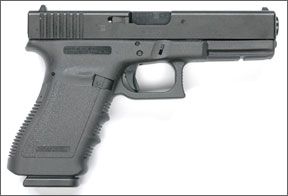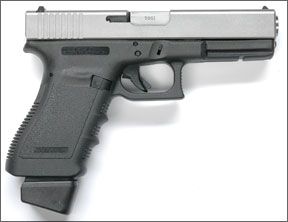Alex Zimmerman has a great idea. We first experienced it a while back in our review of one of his Guncrafter Industries’ 50-caliber 1911s, which we found to be a well-made handgun, if a bit on the costly side. Zimmerman’s idea is to give the shooter something more without the cost of broken hands. Rather than a bang-up, hot and heavy blaster, the 50 GI is a throwback to older times when big bullets traveled at low velocities and got the job done at least as well as any small-caliber, high-velocity round. Some 200 years ago the norm was single-shot or occasional double flintlock pistols, which commonly threw balls of up to 12-bore in size at velocities in the low- to middle-hundreds of feet per second. But wait!, cried the “engineers.” Those low-velocity rounds are all wrong, they said. They don’t develop the muzzle energy of these new-fangled, higher-speed rounds, which depend on velocity squared to get their (largely misleading) high numbers. Thus, in today’s terms, a 9mm high-velocity round can equal the “power” of a 45 ACP, at least on paper. In the real world, those with experience know this is not quite the whole picture. Many experts always go for the bigger bore with heavy bullets.

The grand master of elephant hunting, John “Pondoro” Taylor, did practical studies over many years to test his own theories along similar lines, and to his satisfaction proved his theories to be correct. He found that big bullets at reasonable velocities work better than smaller ones at outrageous velocities. Taylor derived a simple formula that may be applied to handgun rounds today, though Taylor never intended that kind of comparison.
Taylor’s “knock-out” blow (KO) is derived from the velocity (not squared), times the bullet weight, times the bullet diameter, divided by a constant to keep the numbers reasonable. Thus he put equal emphasis on bullet weight, diameter, and velocity. A 230-grain 45 auto ball load, at 850 fps, may be looked at this way:
KO (45 ACP) = 230.x .45 x 850/7000 = 12.6
A hot 9mm might use a 115-grain bullet at 1200 fps. Its Taylor value is thus:
KO (9mm) = 115 x .355 x 1200/7000 = 7.0
These two rounds develop essentially identical muzzle energy, just under 370 foot-pounds. Many experienced shooters maintain the Taylor value is a better indicator than muzzle energy of how these two cartridges actually work in the field.
Bullet nose shape or design is not a factor in the Taylor formula. There are other, similar, formulas that apply a form factor to the bullet nose, but for general non-complicated evaluation of rifle and handgun cartridges, some of us have found this simple formula works exceedingly well, and clears away a whole lot of the advertising spin that is commonly applied to new, exotic and soon-to-be-famous cartridges. If you get thinking in terms of bullet diameter, weight, and speed instead of published energy figures, you quickly get a feel for what any rifle or handgun cartridge can do, and you’ll also see through much of the misleading hype.
So what Alex Zimmerman has done is offer a package that maximizes handgun bullet diameter, and Taylor KO values, without blasting your hand away at the grip end. For this report we got the loan of a 50-GI conversion kit ($595) for Glock 21 autos. We also acquired a Glock 21 (street price $575) and because the obvious comparison cartridge is the 45 ACP, we shot the Glock as both a 45 and a 50 GI. Here’s our report.
Glock 21 45 ACP, $575

The Glock is a well-proven design, but it had been a while since our team in Idaho had one. On opening the box and picking up the handgun, we were somewhat taken aback by the huge, clumsy shape of the grip. A slimmer-grip, full-size model is apparently not available, per Glock’s website. The Glock 21 is a big pistol. Its slide is 1.125 inches wide, and the gun is over 8 inches long. It’s all matte black, with finger grooves on the front strap and coarse checkering on the back. Its major safety feature, as any gunny knows by now, is its famous trigger with its spring-loaded insert that prevents the trigger from moving until the insert is depressed. The blocky frame includes a light rail beneath the muzzle. The white-outlined sights present a good picture but are not height adjustable short of replacing the rear sight insert, an option offered by Glock. The rear can be drifted for windage.
The dovetailed rear sight can hurt your hand in a clearance drill, but that’s easy to fix with a pocket knife, because the insert is soft plastic. The wide magazine holds 13 rounds of 45 ACP. Two mags come with the Glock along with a loading aide. The magazine drops free with the touch of the right-hand thumb, or left index finger for southpaws (it’s not reversible), on a square button behind the trigger guard. The gun can be fired with the magazine removed. The slide is held to the rear after the last shot, and there’s a left-side release that could speed up reloads if it were easy to use. It’s not, because it’s too small.
Takedown of the Glock is mighty simple. Remove the mag and clear the gun. Then, pull slightly rearward on the slide and pull down on the little sliding plate that sticks out both sides of the frame just above the trigger. Holding that plate down, let go of the slide, press the trigger if its cocked, and the slide comes off the front. Pop out the captive slide spring and the barrel can be removed for easy cleaning. Reassembly is just as fast. Glocks are easy to keep clean. This in fact makes it very easy to change your 45 Glock into a 50 GI Glock.

We fired the Glock Model 21 with a trio of common 45 loads to get a feel for the thing. The loads were Black Hills 230-grain ball, Federal Classic 230-grain JHP Hi-Shok, and Cor-Bon 185-grain +P JHP. As expected, there were no failures of any kind, though we were not stunned by the gun’s accuracy. We hated its trigger, which was too stiff at about 8 pounds, not the 5.5 advertised. The trigger did not contribute in any way to the gun’s accuracy potential. Best groups were around 1.5 inches, which the Glock did with both Cor-Bon and Black Hills. Worst was 3.0 inches, which was with the Federal load.
Our Team Said: In a nutshell, if we wanted a 45 auto for general use it would not be this Glock. It was too big, had a too-heavy trigger, and had only average accuracy at best. We thought the slide release was too small and too hard to work. The gun’s good points were easy takedown, simple controls, and good functionality. We thought the gun would be vastly improved with a smaller grip (we don’t have tiny hands) and a much better trigger. We believe there are a lot more user-friendly 45 pistols out there. S&W’s M&P comes immediately to mind.
Guncrafter Industries 50 GI Conversion, $595
This conversion set consisted of a slide, barrel, captive slide spring, and magazine in a hard plastic case. Comparing the conversion’s parts with the Glock 21’s equivalent parts showed us the Guncrafter Industries machining was at least as good as Glock’s. Further, the GI parts were stainless, with a pleasing matte finish to the slide. The slide and barrel were machined from stainless forgings. The sights appeared to be Glock parts, made of plastic and readily replaceable. The barrel had normal rifling, not the segmented style used by Glock. There are two magazine types available, a normal-looking one that holds eight rounds, and the extended one that came with our conversion, with nine-round capacity.
Installing this well-made unit was extremely easy. We simply took off the Glock 45 slide and barrel and slipped on the Guncrafter unit, loaded the 9-round extension magazine and went to work. We could actually get ten rounds into the mag, but it’s not recommended. The big 50 GI rounds came in two flavors, 275-grain JHP and 300-grain flat point. The 275-grain load at a measured 905 fps (875 claimed), gave 500 foot-pounds of muzzle energy and a KO value of 17.8. The 300-grain load, our favorite, chrono’ed at 735 fps instead of the claimed 700, which gave 360 foot-pounds, and a Taylor KO value of 15.8.
The gun felt exactly the same in our hands as did the 45, same balance and essentially the same weight. With the magazine loaded, the weight and balance were again pretty close to the 45 version. On the range, we noticed a bit more pounding to the hand with the 275-grain JHP load, but it was by no means uncomfortable or uncontrollable. If you didn’t know, we suspect you’d have a hard time telling if you were shooting a 45 load or a 50 GI. We were again hampered by the lousy trigger of this Glock 21, but we were able to shoot groups about equal to those from the 45 setup. Best were 1.9 inches with the 275-grain load and 1.7 with our favored 300-grain bullet. There were no failures of any kind, though we noted a slight sluggishness for the slide to go fully forward for the first few rounds. This went away with just a touch of wearing in.
Rapid-fire results were about equal between the 45 and 50 GI, with the nod actually going to the 50 GI. This is probably because we were aware we had a bit more power, and were a bit more careful. We slightly preferred the 300-grain bullet for rapid-fire. Ammunition is available from GI, and they also offer loading dies and brass. None of it is especially cheap, but not much in the firearms ammunition world today is. We found the ammo to be very well made, packed 20 to a box, and excellent in performance and consistency.
Our Team Said: The cost was reasonable, we felt, in that you’re getting something you can’t get any other way. Of course for the price of the conversion you could get another Glock, but you can’t get a 50 GI easier nor cheaper, so far as we know. If you have a Glock 21 or 20 and have a hankering for more usable power without going to a magnum blaster, this conversion might be just right for you. We hope there’s a unit in the works for the S&W M&P, or perhaps for another good modern auto pistol.
































